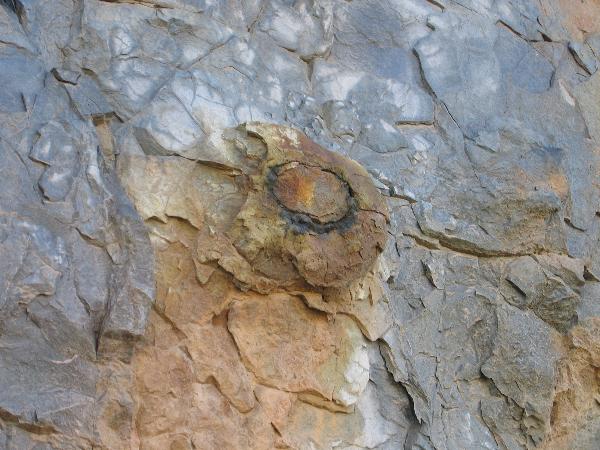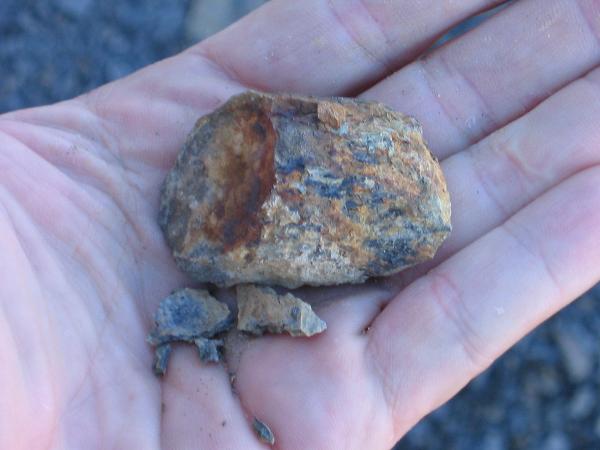 Hundreds of fossil trees, remains of Canada's oldest known forests,
were discovered near Norton, NB. The trees were exposed during the
widening of Highway 1 between Sussex and Norton. The forests date
from a time when eastern Canada lay on the equator and was covered
by steamy tropical rainforests. The trees were moss-like plants
that grew to 20 meters high. These fossil forests are 40-45 million
years older than Nova Scotia's famous Joggins fossil forest, which
is currently being promoted as a potential UNESCO world heritage
site. Therefore, this find is incredibly significant as Canada's
oldest known forest. Scientists have counted almost 700 trees at
the site and estimate that there were 10,000 to 25,000 trees to the
hectare. The forests were incredibly dense, and would give a whole
new meaning to "bushwhacking". At the rock face opposite the mile
marker, you will see numerous fossilized tree trunks sticking out
of the rock face.
Hundreds of fossil trees, remains of Canada's oldest known forests,
were discovered near Norton, NB. The trees were exposed during the
widening of Highway 1 between Sussex and Norton. The forests date
from a time when eastern Canada lay on the equator and was covered
by steamy tropical rainforests. The trees were moss-like plants
that grew to 20 meters high. These fossil forests are 40-45 million
years older than Nova Scotia's famous Joggins fossil forest, which
is currently being promoted as a potential UNESCO world heritage
site. Therefore, this find is incredibly significant as Canada's
oldest known forest. Scientists have counted almost 700 trees at
the site and estimate that there were 10,000 to 25,000 trees to the
hectare. The forests were incredibly dense, and would give a whole
new meaning to "bushwhacking". At the rock face opposite the mile
marker, you will see numerous fossilized tree trunks sticking out
of the rock face.
Also, at N45 36.224 W65 43.655, there
are loads of fossils in the rock debris on the ground at the base
of the cut. You can look through this rubble and find a fossil
specimen. Since this is such a potentially sensitive area, please
do not cut fossils out of the rock face, and leave any specimen
that you do find on the site.

In order to log this earthcache you need to
complete the following tasks:
1. post a picture of yourself with the
fossilized tree trunks in the background.
2. estimate the width of the
cross-section(s) of the fossilized tree trunks in your picture.
E-mail me your results.
3. find a fossil at the base of this rock
face, or at the other coordinates listed above. Post a picture of
your find, with your GPSr in the picture, and e-mail me a
hypothesis (reasoned guess) as to what your fossil is.
 A Lesson in Fossilization
A Lesson in Fossilization
Fossilisation is a process that will only take place if certain
conditions/factors are present. Many factors can influence how
fossils are preserved. Remains of an organism may be replaced by
minerals, dissolved by an acidic solution to leave only their
impression, or simply reduced to a more stable form. The
fossilization of an organism depends on the chemistry of the
environment and on the biochemical makeup of the organism. As a
result, not all organisms in a community will be preserved.
Carbonization Plants are most commonly fossilized through
carbonization. In this process, the mobile oils in the plant's
organic matter are leached out and the remaining matter is reduced
to a carbon film. Plants have an inner structure of rigid organic
walls that may be preserved in this manner, revealing the framework
of the original cells. Animal soft tissue has a less rigid cellular
structure and is rarely preserved through carbonization.
Petrifaction Another common mode of preservation of
plants is petrifaction, which is the crystallization of minerals
inside cells. One of the best-known forms of petrifaction is
silicification, a process in which silica-rich fluids enter the
plant's cells and crystallize, making the cells appear to have
turned to stone (petrified). Famous examples of silicification may
be found in the petrified forests of the western United.
Petrifaction may also occur in animals when minerals such as
calcite, or silica fill the pores and cavities of fossil shells or
bones.
Replacement/Sedimentation Replacement occurs when an
organism is buried in mud and its remains are replaced by sulfide
(pyrite) or phosphate (apatite) minerals. This process may replace
soft tissue, preserving rarely seen details of the organism's
anatomy. Paleontologists have used mild acids to etch the
phosphatized fossil remains of ancient fish found in Brazil to
reveal structures such as gills and muscles. Although mineral
replacement is rare, fossils created in this way are important in
helping paleontologists compare the anatomical details of
prehistoric organisms with those of living organisms.

